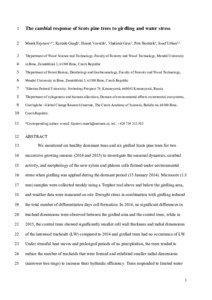The cambial response of Scots pine trees to girdling and water stress
Скачать файл:
URI (для ссылок/цитирований):
https://brill.com/view/journals/iawa/41/2/article-p159_3.xmlhttps://elib.sfu-kras.ru/handle/2311/142728
Автор:
Fajstavr, M
Giagli, K
Vavrcik, H
Gryc, V
Horacek, P
Urban, J
Коллективный автор:
Институт экологии и географии
Кафедра экологии и природопользования
Дата:
2020-05Журнал:
IAWA JournalКвартиль журнала в Scopus:
Q1Квартиль журнала в Web of Science:
Q2Библиографическое описание:
Fajstavr, M. The cambial response of Scots pine trees to girdling and water stress [Текст] / M Fajstavr, K Giagli, H Vavrcik, V Gryc, P Horacek, J Urban // IAWA Journal. — 2020. — Т. 42 (№ 2).Аннотация:
We monitored six healthy dominant trees and six girdled Scots pine trees for two successive growing seasons (2014 and 2015) to investigate the seasonal dynamics, cambial activity, and morphology of the new xylem and phloem cells formed under environmental stress when girdling was applied during the dormant period (15 January 2014). Microcore (1.8 mm) samples were collected weekly using a Trephor tool above and below the girdling area, and weather data were measured on site. Drought stress in combination with girdling reduced the total number of differentiation days cell formation. In 2014, no significant differences in tracheid dimensions were observed between the girdled area and the control trees, while in 2015, the control trees showed significantly smaller cell wall thickness and radial dimensions of the latewood tracheids (LW) compared to 2014 and girdled trees had no occurrence of LW. Under stressful heat waves and prolonged periods of no precipitation, the trees tended to reduce the number of tracheids that were formed and exhibited smaller radial dimensions (narrower tree rings) to increase their hydraulic efficiency. Trees responded to limited water availability by forming intra-annual density fluctuations (IADFs L) in the zone of the LW to overcome stressful conditions. Although xylem cell differentiation was affected by stressful conditions, no significant variability in phloem cell dimensions was observed. Thus, the phloem tissue was less sensitive to exogenous factors. © 2020 International Association of Wood Anatomists.

